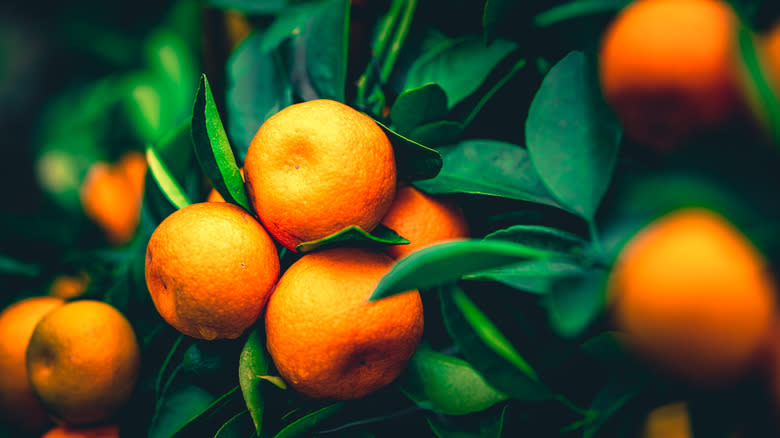The Reason Florida Grocery Stores Rarely Sell Its Homegrown Oranges

Florida is known for many things: Sunshine, theme parks, and citrus. The Sunshine State is one of the largest exporters of oranges in the country, only surpassed in product by California. But if you go to a Florida grocery store don't expect to be buying native Florida oranges. Most of the oranges sold for eating in Florida are exports from California, believe it or not. This may seem confusing given how strongly associated the state is with citrus, but there's actually a specific reason for this. The two states' exports are used for different purposes, Florida's citrus is primarily used for processing. According to Growing Produce, 90% of Florida's oranges are used in processed orange products such as orange juice, concentrate, frozen products, and more.
California on the other hand provides a majority of the oranges we eat in grocery stores, including the ones you might buy from major retail chains in Florida. While it's not impossible to eat a Florida-grown orange, it does take a little more effort. The other 10% of oranges grown in Florida that are not exported are distributed to locally grown markets such as roadside vendors, some farmer's markets, and specific gift boxes according to The Kitchn. If you want to try a Florida orange you're better off going to small independent sellers instead of major chains.
Read more: 13 Simple Tricks To Pick The Best Fresh Fruit Every Time
Why Are Florida Oranges Used For Juice?

Florida oranges have several attributes that make them better suited for juice products versus shelf products. To start, Florida oranges tend to be more unsightly compared to other orange exports. Their outer skin has a greener hue to it, and it appears to look almost bruised even when perfectly edible to eat. Florida oranges are also softer than California oranges, while this softness is what makes them so juicy it also makes them more difficult to transport and sell on shelves. The high juice content in Florida oranges makes them the obvious choice to use for juicing.
In comparison, California oranges have a traditional orange look to them. There are also stricter regulations on California oranges from the Department of Agriculture. Regulation "medium" oranges from California must be three inches in diameter. In comparison oranges sold from Florida only need to be two and 4/16 inches in diameter.
Florida crops have also suffered from citrus "greening" disease, which has been circulating among Florida orange crops since 2005. This disease comes from Asian citrus psyllid, which transfers bacteria to healthy Florida orange trees and eventually renders the tree unable to produce fruit. This ongoing issue has impacted Florida's production ability greatly and contributes to why you won't see many Florida oranges for sale. This disease is also part of why orange juice prices have skyrocketed in recent years. While Florida oranges are still available to be eaten, it has gotten significantly harder to do so.
Read the original article on Tasting Table.

